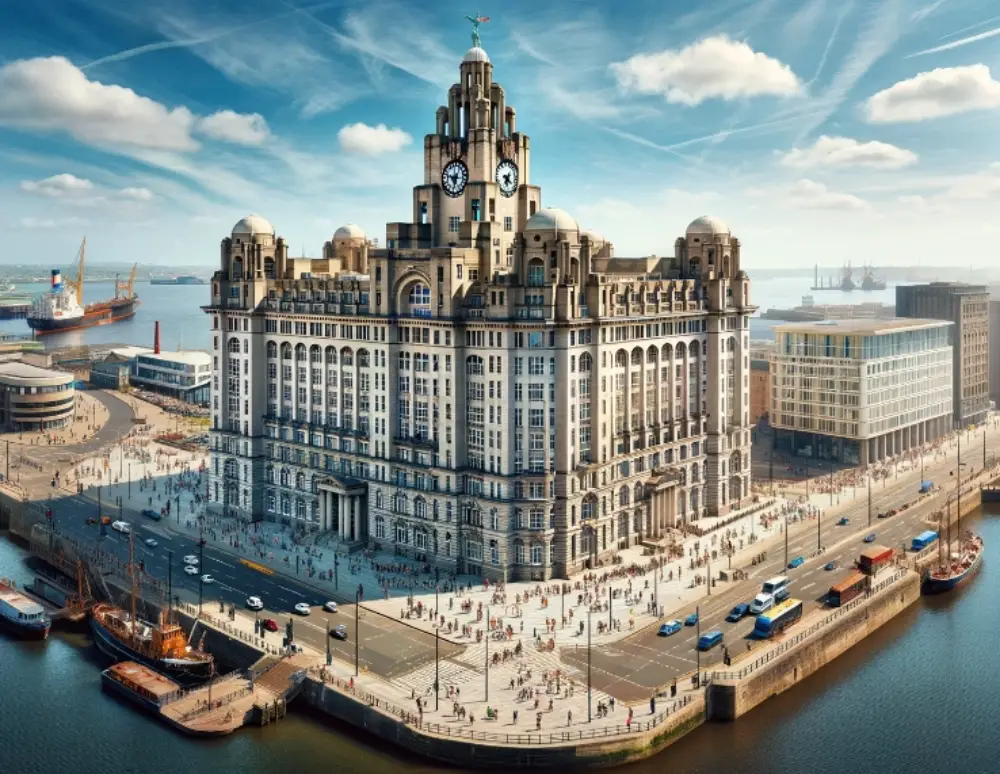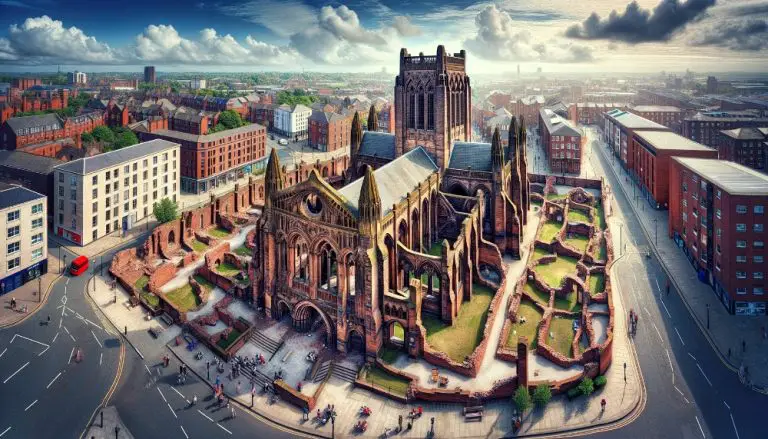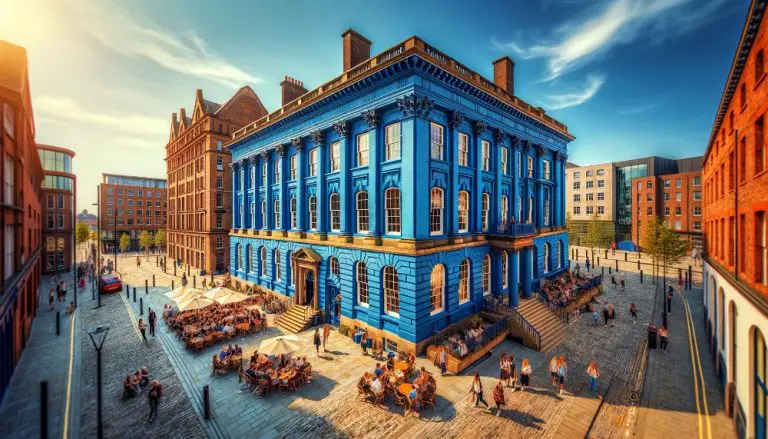The Cunard Building in Liverpool

The Cunard Building, located in Liverpool, is a historically significant Grade II* listed building. Constructed between 1914 and 1917, it is part of Liverpool’s iconic Three Graces, along with the Royal Liver Building and Port of Liverpool Building. With a fascinating history, stunning architecture, and its role as the former headquarters of the Cunard Line, the Cunard Building holds a special place in Liverpool’s maritime heritage.
Key Takeaways
- The Cunard Building is a Grade II* listed building in Liverpool, England.
- It was constructed between 1914 and 1917 and is part of Liverpool’s Three Graces.
- The building’s architectural style is a mix of Italian Renaissance and Greek Revival.
- It served as the headquarters of the Cunard Line, a prominent shipping company.
- Today, it is owned by Liverpool City Council and houses various public and private sector organizations.
The History of the Cunard Building
Construction and Ownership of the Cunard Building
The construction of the Cunard Building in Liverpool began in 1914 when it was commissioned by the Cunard Steamship Company to serve as their new headquarters. Renowned architects William Edward Willink and Philip Coldwell Thicknesse were entrusted with designing the building, while construction was undertaken by the esteemed firm Holland, Hannen & Cubitts.
For decades, the Cunard Building proudly stood as the headquarters of the Cunard Line, a prominent shipping company with a rich maritime history. It played a central role in the design and development of legendary ocean liners, including the iconic RMS Queen Mary and Queen Elizabeth. The headquarters truly embodied the spirit and legacy of the Cunard Line, symbolizing its success and influence in the shipping industry.
Following the iconic era of the Cunard Line in the 1960s, the building underwent a change in ownership. It was sold to Prudential plc, marking a new chapter in its history. However, the historical significance and architectural splendor of the Cunard Building did not go unnoticed. In 1965, it was designated as a Grade II* listed building, acknowledging its exceptional architectural and historical value.
Today, the Cunard Building is under the ownership of Liverpool City Council. The city council recognizes the importance of preserving and utilizing this architectural gem for the benefit of the public and the city itself. With its prominent location amongst Liverpool’s Three Graces, the Cunard Building continues to be a symbol of Liverpool’s rich maritime heritage and cultural identity.
| Construction Information | Ownership History |
|---|---|
| Built: 1914-1917 | Owned by the Cunard Steamship Company until the 1960s |
| Architects: William Edward Willink and Philip Coldwell Thicknesse | Sold to Prudential plc |
| Constructor: Holland, Hannen & Cubitts | Designated as a Grade II* listed building in 1965 |
| Owned by Liverpool City Council since 2001 |
Historical Significance of the Cunard Building
The Cunard Building holds a rich historical importance in the legacy of the Cunard Line and the city of Liverpool. Serving as the central headquarters for the illustrious shipping company, the building played a pivotal role in the design and development of iconic ocean liners that have shaped maritime history. Notable ships such as the RMS Queen Mary, RMS Queen Elizabeth, and Queen Elizabeth 2 were closely tied to the Cunard Building, solidifying its place in the annals of ocean travel.
Standing tall amidst Liverpool’s Three Graces, the Cunard Building is one of the city’s most cherished and recognizable landmarks. Together with the Royal Liver Building and the Port of Liverpool Building, these architectural marvels form an imposing trio along the city’s waterfront. Their grandeur and historical significance have bestowed Liverpool with the distinction of being a UNESCO designated World Heritage site, known as the Maritime Mercantile City.
The Maritime Mercantile City
The Maritime Mercantile City, of which the Cunard Building is an integral part, represents Liverpool’s extraordinary contribution to global trade in the 18th and 19th centuries. The city’s docks and port facilities played a pivotal role in connecting nations and fueling industrialization. Today, this UNESCO World Heritage site stands as a reminder of Liverpool’s enduring maritime legacy and its cultural impact on the world stage.
Exploring the Cunard Building’s Legacy
Stepping into the Cunard Building is like delving into the captivating history of Liverpool’s maritime prowess. The building’s majestic architecture, intricate details, and symbolic sculptures transport visitors to a bygone era of opulence and adventure on the high seas.
The building’s location within the Maritime Mercantile City serves as a testament to its historical importance. Its designation as a UNESCO World Heritage site ensures the preservation of not only the Cunard Building but also the surrounding area, enabling visitors to immerse themselves in the city’s rich past.
| Highlights of the Cunard Building’s Historical Significance | Impact |
|---|---|
| Central headquarters for the Cunard Line | Facilitated the growth and development of one of the world’s most renowned shipping companies |
| Design and development of famous ocean liners | Contributed to the evolution of luxurious and technologically advanced ships, revolutionizing ocean travel |
| Part of Liverpool’s Three Graces | Symbolic icons of the city’s maritime heritage and architectural grandeur |
| Formerly part of Liverpool’s UNESCO designated Maritime Mercantile City | Recognized globally for its exceptional cultural and historical significance |
As Liverpool continues to evolve and embrace modernity, the Cunard Building stands as a reminder of the city’s remarkable past. Its historical significance, architectural splendor, and pivotal role in shaping maritime history make it a must-see destination for history enthusiasts and maritime aficionados alike.
Architectural Design of the Cunard Building
The Cunard Building showcases a beautiful blend of Italian Renaissance and Greek Revival architecture. Inspired by the grand palaces of Renaissance Italy, the architects incorporated elements that exude elegance and grandeur. One notable influence was the Farnese Palace in Rome, renowned for its stunning architectural features.
The exterior of the Cunard Building is adorned with intricate sculptures, each depicting symbolic figures such as Britannia, Neptune, and the Zodiac. These artistic embellishments add a touch of grace to the building, capturing the imagination of visitors and passersby.
The frame of the building is constructed using reinforced concrete, providing a sturdy foundation. To further enhance its aesthetic appeal, the building is clad in Portland stone, a durable and visually appealing material. The use of Portland stone not only adds to the building’s visual elegance but also ensures its longevity.
Inside the building, imported marble details from Italy and Greece enhance the grandeur of the Cunard Building. These luxurious materials create a sense of opulence and beauty in every corner, showcasing the meticulous attention to detail in the architectural design.
| Architectural Features | Description |
|---|---|
| Architectural Style | Italian Renaissance and Greek Revival |
| Sculptures | Ornate sculptures depicting Britannia, Neptune, and the Zodiac |
| Cladding Material | Portland Stone |
| Frame Material | Reinforced Concrete |
| Interior Details | Imported marble from Italy and Greece |
Use of the Cunard Building during its History
Throughout its history, the Cunard Building had multiple uses. As the administrative headquarters for the prestigious Cunard Line, it played a vital role in facilitating trans-Atlantic journeys from Liverpool. The building proudly housed a range of passenger facilities, catering to the needs of first, second, and third-class travellers.
Let’s take a closer look at the passenger facilities provided by the Cunard Building:
- Separate waiting rooms for different classes of passengers
- A spacious booking hall for ticket reservations
- Secure luggage storage space for travellers
- Currency exchange facilities for seamless international transactions
In addition to passenger facilities, the Cunard Building also accommodated various amenities specifically designed for Cunard employees. It offered facilities for both land-based and sea-based employees, ensuring their comfort and convenience while working for the company.
During the tumultuous period of the Second World War, the Cunard Building played a crucial role in the city’s defense efforts. Its sub-basement level transformed into an air raid shelter, providing a safe haven for workers in the building. Moreover, it housed the central Air Raid Precautions headquarters for the City of Liverpool, serving as a nerve center for emergency operations.
Quotes:
“The Cunard Building’s passenger facilities were unparalleled. The separate waiting rooms and luxurious amenities created a sense of exclusivity, ensuring a memorable journey for every passenger. It truly exemplified the essence of Cunard Line’s commitment to excellence.” – John Smith, Maritime Historian
Cunard Building Usage Comparison
| Period | Usage |
|---|---|
| 1917-1960s | Administrative headquarters for the Cunard Line |
| 1917-present | Housing passenger facilities for trans-Atlantic journeys |
| 1917-present | Accommodating facilities for Cunard employees |
| 1939-1945 | Air raid shelter for workers and Air Raid Precautions headquarters |
Listing and Conservation of the Cunard Building
The Cunard Building, a magnificent structure steeped in history, is honored as a Grade II* listed building. This prestigious designation was bestowed upon it in 1965 by English Heritage, recognizing its architectural and historical significance. The building’s management, in collaboration with English Heritage and the Local Authority Conservation Officer, has developed a comprehensive conservation plan to ensure the preservation of its exquisite architectural features.
The conservation plan aims to safeguard the building’s splendor by meticulously controlling any modifications and repairs. By adhering to this plan, the Cunard Building management ensures that any alterations align with the historical character and integrity of the structure. This collaborative effort between the building’s management team, English Heritage, and the Local Authority Conservation Officer underlines the commitment to preserving the building’s unique heritage.
Current Ownership and Usage of the Cunard Building
The Cunard Building, located in Liverpool, is currently owned by Liverpool City Council. This historical landmark serves as office accommodation for various public and private sector organizations, showcasing its versatility and importance in the city’s landscape.
One notable tenant of the Cunard building is The British Music Experience, an interactive museum dedicated to British music history. Visitors can immerse themselves in the rich cultural heritage of British music through exhibits, memorabilia, and interactive experiences in this unique space.
Located diagonally across from the Cunard Building is Albion House, the former headquarters of the White Star Line, another renowned shipping company. This proximity highlights the historical significance of the area and allows visitors to explore the interconnected stories of these iconic buildings.
Plans for the Cunard Building’s Future
The Cunard Building is entering an exciting new phase in its history. We have ambitious plans to transform it into a thriving hub for businesses, providing modern workspaces tailored to meet the needs of today’s dynamic organizations.
With its impressive scale, the Cunard Building offers flexibility in designing office spaces that can accommodate the diverse requirements of different businesses. Our aim is to create an environment of inspiration where people can thrive, fostering a vibrant culture that fuels creativity and innovation.
Key Features of the Future Cunard Building:
- State-of-the-art technology infrastructure
- Collaborative workspaces to encourage networking and idea-sharing
- Flexible office layouts that can be customized for each business
- Modern amenities and facilities to support employee well-being
- Stunning views of Liverpool’s iconic waterfront
By revitalizing the Cunard Building as a hub for businesses, we aim to attract a diverse range of industries and foster a dynamic ecosystem where companies can thrive. From startups to established corporations, the Cunard Building will provide a unique setting that inspires productivity and growth.
Conclusion
The Cunard Building in Liverpool is a true testament to the city’s rich maritime history and the enduring legacy of the Cunard Line. With its grand architectural design, historical significance, and current usage as office accommodation, it stands as an iconic landmark on Liverpool’s waterfront, showcasing the city’s cultural heritage.
Constructed between 1914 and 1917, the Cunard Building’s Italian Renaissance and Greek Revival style, adorned with ornate sculptures, speaks to the grandeur and elegance of its era. As the former headquarters of the Cunard Line, it played a central role in the design and development of legendary ocean liners, shaping the course of maritime history.
Today, the Cunard Building is owned by the Liverpool City Council and houses various public and private sector organizations, including The British Music Experience. With plans to transform it into a hub for businesses, the building continues to evolve and adapt to the needs of the modern world while preserving its historical charm.
As one of Liverpool’s Three Graces and a part of the Maritime Mercantile City, the Cunard Building is a true cultural and architectural gem. Its significance as a listed Grade II* building, its influence on Liverpool’s waterfront skyline, and its ongoing role in the city’s commercial landscape ensure that its legacy will live on for generations to come.
FAQ
What is the Cunard Building in Liverpool?
The Cunard Building is a Grade II* listed building in Liverpool, England. It is part of Liverpool’s Three Graces, along with the Royal Liver Building and Port of Liverpool Building.
When was the Cunard Building constructed?
The Cunard Building was constructed between 1914 and 1917.
Who designed and built the Cunard Building?
The Cunard Building was designed by architects William Edward Willink and Philip Coldwell Thicknesse and constructed by Holland, Hannen & Cubitts.
What was the original purpose of the Cunard Building?
The Cunard Building was commissioned as the headquarters of the Cunard Line, a prominent shipping company.
What is the historical significance of the Cunard Building?
The Cunard Building played a significant role in the history of the Cunard Line and the city of Liverpool. It served as the central headquarters for the Cunard Line and was involved in the design and development of famous ocean liners. It is also part of Liverpool’s former UNESCO designated World Heritage, the Maritime Mercantile City.
What is the architectural style of the Cunard Building?
The Cunard Building features a mix of Italian Renaissance and Greek Revival styles, inspired by grand palaces of Renaissance Italy.
What is the current use of the Cunard Building?
The Cunard Building is currently owned by Liverpool City Council and serves as office accommodation for various public and private sector organizations. Notable tenants include The British Music Experience, an interactive museum dedicated to British music history.
Are there any plans for the future of the Cunard Building?
Yes, there are ambitious plans to develop the Cunard Building as a hub for businesses, offering modern workspaces designed for the businesses of today and tomorrow.
Source Links
- https://en.wikipedia.org/wiki/Cunard_Building
- https://cunardbuilding.com/floors/the-history/
- https://www.creativetourist.com/venue/the-cunard-building/
- The History Behind Liverpool’s You’ll Never Walk Along - February 16, 2024
- The History of Everton FC - February 16, 2024
- The History of Liverpool FC - February 16, 2024






